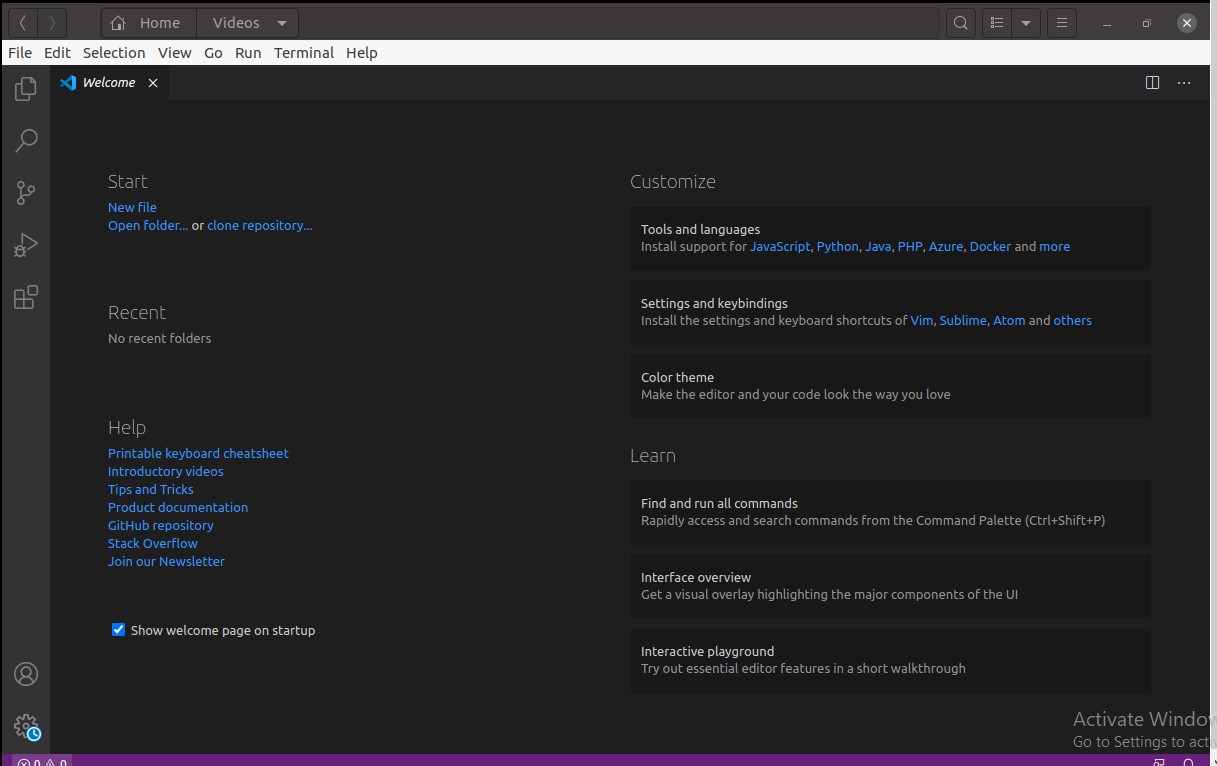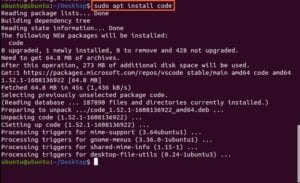
- #UNINSTALL VISUAL STUDIO CODE UBUNTU TERMINAL INSTALL#
- #UNINSTALL VISUAL STUDIO CODE UBUNTU TERMINAL MANUAL#
- #UNINSTALL VISUAL STUDIO CODE UBUNTU TERMINAL PATCH#
- #UNINSTALL VISUAL STUDIO CODE UBUNTU TERMINAL FULL#
- #UNINSTALL VISUAL STUDIO CODE UBUNTU TERMINAL CODE#
It does not require Node.js or any other dependencies to run.
#UNINSTALL VISUAL STUDIO CODE UBUNTU TERMINAL CODE#
The code for the Heroku CLI is also open source. The framework includes a CLI generator, automated documentation creation, and testing infrastructure. oclif is available as a framework for any developer to build a large or a small CLI. The Heroku CLI is built with the Open CLI Framework ( oclif), developed within Heroku / Salesforce.

heroku-guardian - View various configurations within Heroku that help secure your apps, spaces, and users.heroku-pg-extras - Provides extra heroku pg:* commands.heroku-repo - Commands to manipulate an app’s Heroku git repository.heroku-builds - View builds, purge the build cache, and create builds from tarballs.free - Find all your apps that use free dynos, free Heroku Postgres, or free Heroku Data for Redis plans.api - Make ad-hoc API requests (such as heroku api GET /account).See Using CLI Plugins for more information on plugin management.
#UNINSTALL VISUAL STUDIO CODE UBUNTU TERMINAL INSTALL#
Install a CLI plugin with heroku plugins:install someplugin. Latest Release SHAs DarwinĬLI plugins allow you to extend your CLI installation. The heroku binary checks for an up-to-date client in ~/.local/share/heroku/client before using the originally installed client. This background check happens at most once every 4 hours. If a new version is found, it’s downloaded and stored in ~/.local/share/heroku/client. When you run a heroku command, a background process checks for the latest available version of the CLI. The Heroku CLI keeps itself and its plugins (except linked plugins) up to date automatically, unless you installed the Debian/Ubuntu package or used npm install.
#UNINSTALL VISUAL STUDIO CODE UBUNTU TERMINAL FULL#
See Heroku CLI Commands for a full list of commands. done, ⬢ sleepy-meadow-81798Ĭheck out your preferred language’s getting started guide for a comprehensive introduction to deploying your first app.

Now you’re ready to create your first Heroku app: $ cd ~/myappĬreating app. For more information, see Heroku CLI Authentication. Logged in as CLI saves your email address and an API token to ~/.netrc for future use. You can’t use the -i option if you have multi-factor authentication enabled due to a technical dependency on web browsers for verification. Logged in as you’d prefer to stay in the CLI to enter your credentials, run heroku login -i. › Warning: If browser does not open, visit Heroku: Press any key to open up the browser to login or q to exit Enter any key to go to your web browser to complete login. Get Started with the Heroku CLIĪfter you install the CLI, run the heroku login command. If you don’t see that output, and installed the Heroku CLI, check if you have an old heroku gem on your system. To verify your CLI installation, use the heroku -version command: $ heroku -version
#UNINSTALL VISUAL STUDIO CODE UBUNTU TERMINAL PATCH#
This method can cause issues if the CLI’s dependencies become incompatible in minor or patch releases. If you use any of the other installation methods, it includes the proper version of Node.js and doesn’t conflict with any other version on your system.Īlso, this method doesn’t use the yarn lockfile for dependencies like the others do, even if you install with yarn. Heroku uses current releases of Node.js and doesn’t support older versions. It also requires you to use your system’s version of Node.js, which can be older than the version Heroku develops the CLI against. This installation method doesn’t autoupdate. It’s strongly recommended to use one of the other installation methods if possible.

This method is also useful if you want fine-grained control over CLI updates such as in a tested script. You must have node and npm installed already. ARM and BSD must use this installation method.
#UNINSTALL VISUAL STUDIO CODE UBUNTU TERMINAL MANUAL#
Use this manual install method in environments where autoupdating isn’t ideal, or where Heroku doesn’t offer a prebuilt Node.js binary. The CLI is built with Node.js and installable via npm. Install the community-maintained heroku-cli 7.60.1-1: $ yay -S heroku-cli Use the standalone installation for an autoupdating version of the CLI. Install with Ubuntu / Debian apt-get $ curl | sh

xz is much smaller but gz is more compatible. These tarballs are available in gz or xz compression. You can also download one of the following tarballs and extract it yourself. The script requires sudo and isn’t Windows compatible. To set up the CLI in /usr/local/lib/heroku and /usr/local/bin/heroku, run the following script. It contains its own node.js binary and autoupdates. The standalone install is a simple tarball with a binary. Download the appropriate installer for your Windows installation:ģ2-bit installer Standalone Installation with a Tarball


 0 kommentar(er)
0 kommentar(er)
